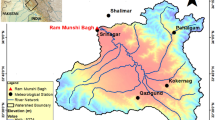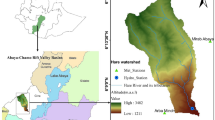Abstract
Flash floods are among the most serious natural hazards. They are associated with exceptional rain events, characterized by short durations, very high intensities and rapid flows. The city of Gabes (South-Eastern Tunisia), located at the outlet of Gabes Basin, is characterized by an erratic rainfall distribution and has been exposed to numerous damaging floods. This study is interested in the study of the phenomenon of flash flood under an arid climate condition through the analysis of the case of Gabes Watershed. More specifically, the objective of this study is to reproduce observed historical peak flows and reconstruct recent flood hydrographs at the outlet of Gabes Basin. The Hydrologic Engineering Center’s Hydrologic Modeling System (HEC-HMS) was used to simulate flood flows entering the city in case of extreme rainfall to determine early warning indicators under different rainfall patterns. The model was calibrated using Soil Conservation Service and Snyder unit hydrographs in order to find the appropriate transfer function. The calibration process was performed on the basis of two statistical evaluation criteria, the NSE (Nash coefficient) and NOF (objective coefficient). The NSE values for calibration varied from 0.90 to 0.95 while NOF values ranged between 0.05 and 0.22, indicating a reasonably good simulation. To further validate the chosen model, simulation of the June 2014 hydrograph was carried out based on the frequency flow estimated empirically. The corresponding Nash and determination coefficient values were found to be around 0.98, which shows very satisfactory results. In a data sparse environment, the findings of this study are essentially valuable for 1D and 2D hydraulic modeling in order to simulate the variation of the water level during a rainfall event. The generation of water depth may then be transposed into floodable areas. Hydrologic simulations can also be valorized in hydraulic design of flood control structures.








Similar content being viewed by others
References
Aryal, S. K., Silberstein, R. P., Fu, G., Hodgson, G., Charles, S. P., & McFarlane, D. (2020). Understanding spatio-temporal rainfall-runoff changes in a semi-arid region. Hydrological Processes, 34(11), 2510–2530.
Beloulou, L., Guechi, S., & Moguedet, G. (2015). The assessment of heavy rains in the region of Annaba (NE Algeria) to improve extreme flood forecasting-use of depth-duration-frequency curves. Journal of Earth Science and Engineering, 5(7), 449–456.
Boithias, L., Sauvage, S., Lenica, A., Roux, H., Abbaspour, K., Larnier, K., Dartus, D., & Sánchez-Pérez, J. (2017). Simulating flash floods at hourly time-step using the SWAT model. Water, 9(12), 929.
Bouillon, H., & Celerier, J. L. (2004). La ville et son assainissement: Principes, méthodes et outils pour une meilleure intégration dans le cycle de l’eau. Environnement & Technique, 237, 40–43.
Bourges, J. (1974). Aperçu sur l’hydrologie du centre sud Tunisien: Réseau d’observations et crues exceptionnelles. O.R.S.T.O.M, Tunisie, pp 1–163.
Cydzik, K., & Hogue, T. S. (2009). Modeling postfire response and recovery using the hydrologic engineering center hydrologic modeling system (HEC-HMS) 1. JAWRA Journal of the American Water Resources Association, 45(3), 702–714.
Dahri, N., & Abida, H. (2017). Monte Carlo simulation-aided analytical hierarchy process (AHP) for flood susceptibility mapping in Gabes Basin (southeastern Tunisia). Environmental Earth Sciences, 76(7), 302.
Dahri, N., & Abida, H. (2020). Causes and impacts of flash floods: Case of Gabes City Southern Tunisia. Arabian Journal of Geosciences, 13(4), 176.
El Alfy, M. (2016). Assessing the impact of arid area urbanization on flash floods using GIS, remote sensing, and HEC-HMS rainfall–runoff modeling. Hydrology Research, 47(6), 1142–1160.
Elbadaoui, K., Algouti, A., Algouti, A., Aitmlouk, M., & Farah, A. (2020). Flood risk modelling using hydrologic data, HECRAS and GIS tools: Case of Toudgha River (Tinghir, Morocco). Disaster Advances Journal, 13 (5).
Fehri, N. (2014). L’aggravation du risque d’inondation en Tunis : éléments de réflexion. Physio-Géographie, 8, 149–175. http://physio-geo.revues.org/3953.
Fehri, N., & Zahar, Y. (2016). Étude de l’impact de l’extension et de la densification du tissu urbain sur les coefficients de ruissellement dans le bassin versant des oueds El-Ghrich et El-Greb (Tunis) par l’application de la méthode SCS aux évènements de septembre 2003. Physio-Géo Géographie Physique et Environnement, 10, 61–79.
Fersi, M. (Ed.): Etude hydrologique d’oued Oum Zessar a Koutine, ` Ministere de l’Agriculture, Tunis, (1985).
Gaume, E., Bain, V., Bernardara, P., Newinger, O., Barbuc, M., Bateman, A., Blaškovičová, L., Blöschl, G., Borga, M., Dumitrescu, A., & Daliakopoulos, I. (2009). A compilation of data on European flash floods. Journal of Hydrology, 367(1–2), 70–78.
Grimaldi, S., & Petroselli, A. (2015). Do we still need the rational formula? An alternative empirical procedure for peak discharge estimation in small and ungauged basins. Hydrological Sciences Journal, 60(1), 67–77.
Gumbel, E. J. (1958). Statistics of extremes. Columbia University Press.
Han, J. (2010). Streamflow analysis using ArcGIS and HEC GeoHMS. Texas A&M University.
Hooke, J. (2006). Hydromorphological adjustment in meandering river systems and the role of flood events. IAHS Publication, 306, 127.
Ibbitt, R. P., & O’Dannell, T. (1971). Fitting methods for conceptual catchments models. Journal of the Hydraulics Division, 97(9), 1331–1342.
Kaufmann de Almeida, I., Kaufmann Almeida, A., Garcia Gabas, S., & Alves Sobrinho, T. (2017). Performance of methods for estimating the time of concentration in a watershed of a tropical region. Hydrological Sciences Journal, 62(14), 2406–2414.
Kendall, M. A. U. R. I. C. E. (1975). Rank correlation methods. Charles Griffin.
Lam, D., Leon, L., Hamilton, S., Crookshank, N., Bonin, D., & Swayne, D. (2004). Multi-model integration in a decision support system: A technical user interface approach for watershed and lake management scenarios. Environmental Modelling & Software, 19(3), 317–324.
Latron, J., Llorens, P., & Gallart, F. (2009). The hydrology of Mediterranean mountain areas. Geography Compass, 3(6), 2045–2064.
Mann, H. B., & Whitney, D. R. (1947). On a test of whether one of two random variables is stochastically larger than the other. The Annals of Mathematical Statistics, 18, 50–60.
McCuen, R. H., & Snyder, W. M. (1986). Hydrologic modeling: statistical methods and applications (No. 627.0724 M22).
Moore, R. J., Cole, S. J., Bell, V. A., & Jones, D. A. (2006). Issues in flood forecasting: Ungauged basins, extreme floods and uncertainty. IAHS Publications-Series of Proceedings and Reports, 305, 103–122.
Musy, A., & Higy, C. (1998). Hydrologie appliquée (No. BOOK). Edition H* G* A.
Musy, A., & Higy, C. (2004). Hydrologie: Une science de la nature (Vol. 21). PPUR presses polytechniques.
Natural Resources Conservation Service (NRCS). (1986). Urban hydrology for small watersheds (No. 55). Washington, DC: Technical release, U.S. Department of Agriculture.
Nash, J. E., & Sutcliffe, J. V. (1970). River flow forecasting trough. 1: A conceptual model discussion of principles. Journal of hydrology, 10(3), 282–290.
Ouarda, T. B., Girard, C., Cavadias, G. S., & Bobée, B. (2001). Regional flood frequency estimation with canonical correlation analysis. Journal of Hydrology, 254(1–4), 157–173.
Petropoulos, G. P., Ireland, G., & Barrett, B. (2015). Surface soil moisture retrievals from remote sensing: Current status, products & future trends. Physics and Chemistry of the Earth, Parts a/b/c, 83, 36–56.
Ponce, V. M. (1989). Engineering hydrology: Principles and practices (Vol. 640). Prentice Hall.
Ramly, S., & Tahir, W. (2016). Application of HEC-GeoHMS and HEC-HMS as rainfall–runoff model for flood simulation. In ISFRAM 2015 (pp. 181–192). Springer, Singapore.
Satheeshkumar, S., Venkateswaran, S., & Kannan, R. (2017). Rainfall–runoff estimation using SCS–CN and GIS approach in the Pappiredipatti watershed of the Vaniyar sub basin, South India. Modeling Earth Systems and Environment, 3(1), 24.
Sen, Z., & Al-Suba’i, K. (2002). Hydrological considerations for dam siting in arid regions: a Saudi Arabian study. Hydrological sciences journal, 47(2), 173–186.
Sharafati, A., & Pezeshki, E. (2020). A strategy to assess the uncertainty of a climate change impact on extreme hydrological events in the semi-arid Dehbar catchment in Iran. Theoretical and Applied Climatology, 139(1–2), 389–402.
Sharifi, S., & Hosseini, S. M. (2011). Methodology for identifying the best equations for estimating the time of concentration of watersheds in a particular region. Journal of Irrigation and Drainage Engineering, 137(11), 712–719.
Soualmia, A., & Gharbi, M. (2014). Tests de simulations des crues éclair. Lebanese Science Journal, 15(2), 13.
Vahabzadeh, G., Saleh, I., Safari, A., & Khosravi, K. (2013). Determination of the best method of estimating the time of concentration in pasture watersheds (case study: Banadak Sadat and Siazakh Watersheds, Iran). Journal of Biodiversity and Environmental Sciences (JBES), 3(12), 150–159.
Viglione, A., Merz, R., & Blöschl, G. (2009). On the role of the runoff coefficient in the mapping of rainfall to flood return periods. Hydrology and Earth System Sciences, 13(5), 577–593.
Wald, A., & Wolfowitz, J. (1943). An exact test for randomness in the non-parametric case based on serial correlation. The Annals of Mathematical Statistics, 14(4), 378–388.
Wałęga, A. (2013). Application of HEC-HMS programme for the reconstruction of a flood event in an uncontrolled basin/Zastosowanie programu HEC-HMS do odtworzenia wezbrania powodziowego w zlewni niekontrolowanej. Journal of Water and Land Development, 18(9), 13–20.
Werren, G. (2013). Maps as risk mitigation tools. Adaptation of the Swiss hazard assessment and mapping methodology to a Moroccan site, Géovisions, 44.
Werren, G., Reynard, E., Lane, S. N., & Balin, D. (2016). Flood hazard assessment and mapping in semi-arid piedmont areas: A case study in Beni Mellal. Morocco. Natural Hazards, 81(1), 481–511.
Zelelew, D. G., & Langon, S. (2020). Selection of appropriate loss methods in HEC-HMS model and determination of the derived values of the sensitive parameters for un-gauged catchments in Northern Ethiopia. International Journal of River Basin Management, 18(1), 127–135.
Acknowledgements
This work was funded by the Ministry of High Education and Scientific Research in Tunisia.
Author information
Authors and Affiliations
Corresponding author
Ethics declarations
Conflict of interest
The authors declare no conflict of interest.
Additional information
Publisher's Note
Springer Nature remains neutral with regard to jurisdictional claims in published maps and institutional affiliations.
Rights and permissions
About this article
Cite this article
Dahri, N., Abida, H. Hydrologic modeling and flood hydrograph reconstitution under an arid climate condition: case of Gabes Watershed, South-Eastern Tunisia. Environ Dev Sustain 24, 10289–10308 (2022). https://doi.org/10.1007/s10668-021-01865-4
Received:
Accepted:
Published:
Issue Date:
DOI: https://doi.org/10.1007/s10668-021-01865-4




